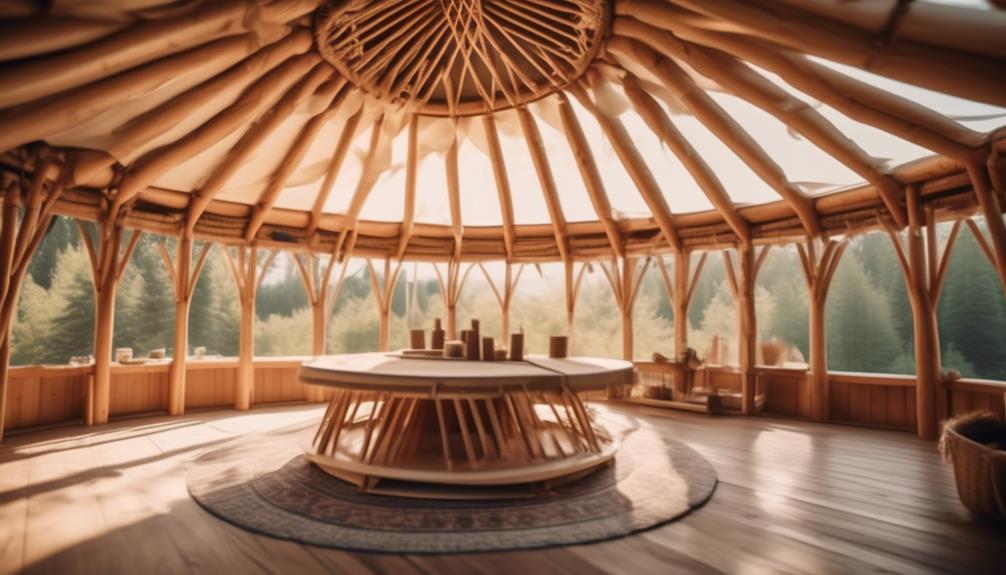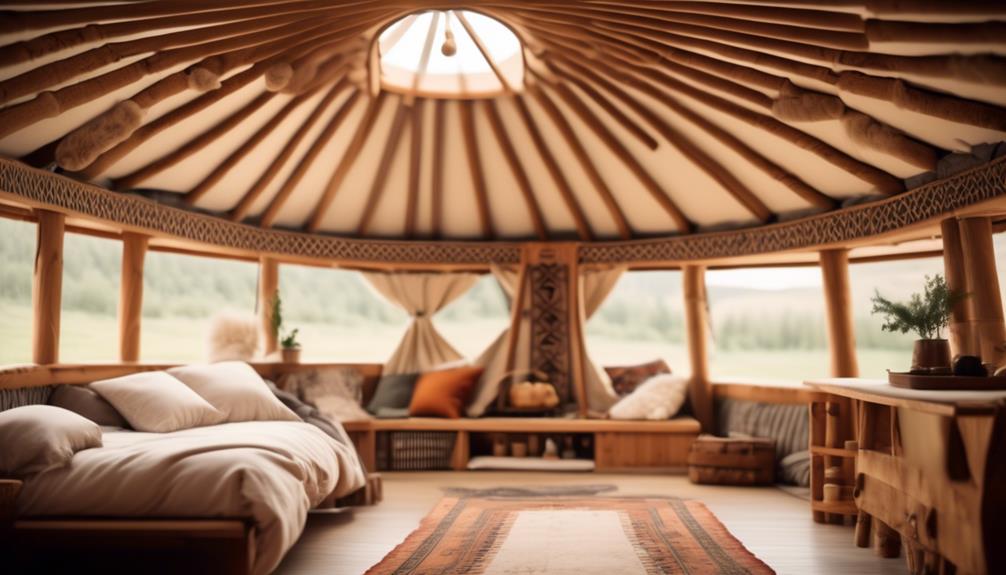Picture yourself in a place where peace and tranquility reign supreme, where the complications of modern life fade away like whispers on the wind. Welcome to the world of yurt living, where freedom and simplicity intertwine to create an experience unlike any other.
But what exactly is a yurt? How does it offer this unique way of living? And most importantly, how can you embrace yurt living and transform your life?
In this article, we will uncover the secrets of yurt living, exploring the allure and beauty that awaits those who dare to venture into this extraordinary lifestyle. Get ready to embark on a journey of discovery, as we unveil the wonders of yurt living and invite you to experience a life filled with freedom and simplicity.
Key Takeaways
- Yurts offer unique benefits such as portability and maximizing space utilization.
- Yurts are constructed using natural materials and have a circular design.
- Setting up a yurt kit involves building a sturdy platform and assembling the lattice walls and roof.
- Living in a yurt comes with challenges such as code enforcement, insulation considerations, security concerns, and the weight of the kit.
What Is a Yurt?
A yurt is a portable, circular tent-like structure that has been used for centuries by nomadic groups as a practical and versatile living space. Unlike traditional homes, yurts offer unique benefits that can revolutionize the way we live.
One of the greatest advantages of yurts is their portability. You can easily transport and set up a yurt in different locations, allowing you to embrace a nomadic lifestyle or simply enjoy the flexibility of moving your home whenever you desire.
Additionally, yurts are known for their efficiency in space utilization. The circular design maximizes the use of every inch, making them feel more spacious and open compared to traditional homes.
Construction and Anatomy of a Yurt
To truly understand the construction and anatomy of a yurt, imagine yourself standing inside a circular, portable structure that's ingeniously designed to maximize space utilization and adaptability. Here's a breakdown of the key elements:
- Yurt materials: Yurts are typically constructed using a combination of natural materials such as wood, canvas, and felt. These materials provide durability, insulation, and a connection to nature.
- Yurt interior design: The interior of a yurt offers a blank canvas for your creativity. With its circular layout, you have the freedom to design the space to suit your needs. From cozy bedrooms to functional kitchens, the possibilities are endless.
- Base of the yurt: The base consists of a platform or foundation that provides stability and elevates the yurt off the ground. It's often made from wood or concrete.
- Lattice walls and rafters: The lattice walls, made of wooden beams, form the structure of the yurt. They provide strength and support for the roof. The rafters, radiating from a central compression ring, create the iconic dome shape and support the roof cover.
Innovative yurt designs and materials allow for a customizable and efficient living space that embraces simplicity and freedom.
Setting Up a Yurt Kit

Now that you have a clear understanding of the construction and anatomy of a yurt, it's time to explore the exciting process of setting up a yurt kit.
Building a yurt platform is the first step in creating your yurt home. Choose a level and sturdy area to build the platform, ensuring it can support the weight of the yurt. The platform can be made of wood, concrete, or even a raised deck.
Once the platform is complete, it's time to assemble the yurt kit. Lay out the lattice wall sections and connect them together, forming a circular shape. Then, attach the rafters to the compression ring at the top of the yurt.
Finally, carefully place the cover over the frame, securing it in place.
With a well-built platform and a properly assembled yurt kit, you'll be ready to experience the freedom and simplicity of yurt living.
Challenges of Living in a Yurt
Living in a yurt brings a unique set of challenges that require careful consideration and planning. Here are some key challenges you may encounter:
- Code enforcement challenges: Many areas have strict building codes and regulations that may not accommodate yurts. It's important to research and understand the local zoning laws before setting up your yurt.
- Yurt insulation considerations: Yurts aren't naturally well-insulated, and maintaining a comfortable temperature can be challenging. You'll need to invest in insulation materials and consider options like double-walled construction or adding a stove for heating.
- Security concerns: Yurts are more vulnerable to break-ins compared to traditional homes. You'll need to implement security measures such as sturdy locks, motion sensor lights, and surveillance cameras to ensure your safety.
- Dealing with the weight of yurt kits: Yurt kits can be heavy, especially if you opt for larger sizes. It's crucial to have a solid foundation and ensure proper setup to support the weight and prevent any structural issues.
Living in a yurt can be a rewarding experience, but it's essential to be aware of these challenges and plan accordingly to make the most of your yurt lifestyle.
Yurt Design and Pricing

Designing a yurt that suits your needs and preferences while staying within your budget requires careful consideration and research. When it comes to yurt design, there are endless possibilities to create a space that reflects your personal style. From cozy and rustic to sleek and modern, the choice is yours.
One important aspect to consider is the interior features of your yurt. You can opt for open-plan layouts, or divide the space into separate rooms using partitions. Additionally, you can choose to install amenities such as a kitchenette, bathroom, or even a loft area.
As for yurt kit pricing, it can vary depending on factors such as size, materials, and additional features. It's important to compare prices from different yurt kit manufacturers to ensure you're getting the best value for your money.
Frequently Asked Questions
How Much Does It Cost to Build a Yurt From Scratch?
Building a yurt from scratch can cost anywhere from $5,000 to $30,000, depending on factors like size, location, and building materials. It's a unique and innovative way to create a cozy and sustainable living space.
Can a Yurt Withstand Extreme Weather Conditions Such as Heavy Snow or Strong Winds?
Yes, a yurt can withstand extreme weather conditions like heavy snow or strong winds. Its structural integrity and insulation effectiveness make it a durable and reliable shelter, providing you with peace of mind in any climate.
How Long Does It Take to Set up a Yurt Kit?
Setting up a yurt kit can take a few days, depending on your experience and the size of the yurt. Challenges faced may include leveling the ground, assembling the lattice walls, and securing the cover. Tips and tricks for a smooth assembly include following the instructions carefully and having a helping hand.
Are There Any Restrictions or Regulations When It Comes to Living in a Yurt?
Zoning regulations vary, but many areas now recognize yurts as permanent dwellings. Some communities even embrace yurt living, offering shared resources and a sense of community. Experience the freedom and simplicity of yurt living today!
What Are Some Creative Ways to Personalize and Decorate the Interior of a Yurt?
Get creative with your yurt interior! Personalize and decorate with DIY yurt decorating tips. Try hanging tapestries, adding cozy rugs, and creating unique storage solutions. Embrace freedom and simplicity with these creative yurt interior ideas.
Conclusion
So, are you ready to experience the freedom and simplicity of yurt living?
With their harmonious blend of nature and unique design, yurts offer a unique way of reconnecting with the natural world.
From waking up to the serene sounds of nature, to embracing the challenges of living in a yurt, this lifestyle is sure to bring a sense of adventure and fulfillment.
So, why wait? Embrace the yurt living experience and unlock a whole new level of freedom and simplicity in your life.

